#mine: sutton and richard
Text




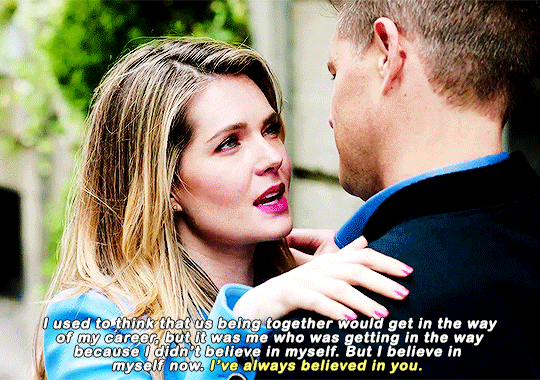


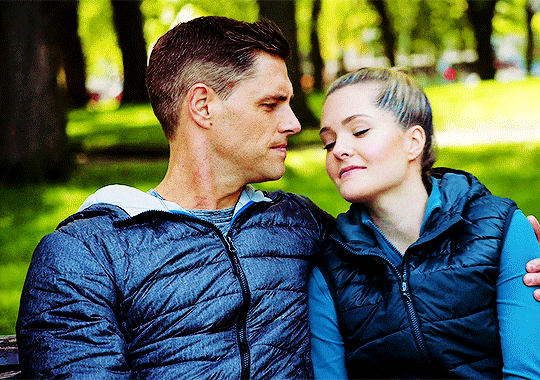
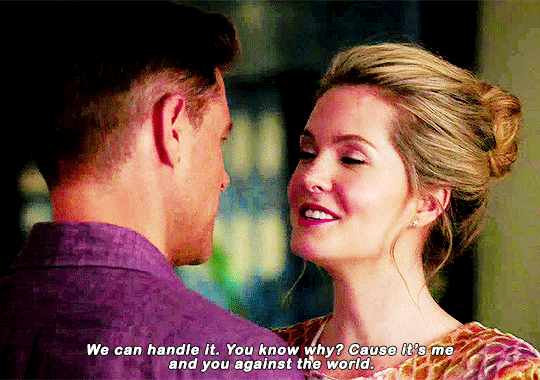

235 FAVORITE SHIPS OF ALL TIME (ranked by my followers)
153. sutton brady and richard hunter - the bold type
#suttard#tbtedit#theboldtypeedit#theboldtypegifs#dailyboldtype#suttardedit#userlolo#sutton brady#richard hunter#the bold type#otp: it's me and you against the world#**#235ships#mine: the bold type#mine: sutton and richard#queue
213 notes
·
View notes
Photo
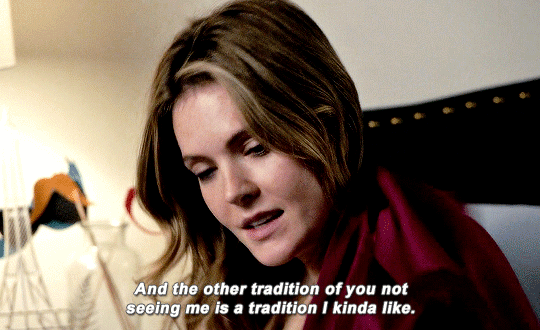




I'm walking myself down the aisle because I'm not a possession to give away.
THE BOLD TYPE (2017–2021)
4.10 Some Kind of Wonderful
#theboldtypeedit#tbtedit#the bold type#suttardedit#tvgifs#dailytvgifs#cinematvedit#filmtvedit#chewieblog#userbbelcher#filmtv#mine: gifs#filmtvcentral#sutton x richard#sam page#meghann fahy#**
135 notes
·
View notes
Text


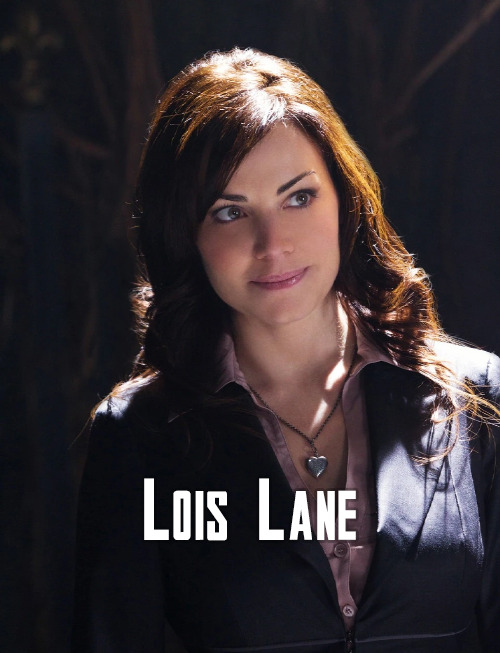





All In's Superfam
#fic: all in#clark kent#lois lane#richard white#jason white#zena white#sutton white#hazel white#mine
1 note
·
View note
Text
Pentiment's Complete Bibliography, with links to some hard-to-find items:
I've seen some people post screenshots of the game's bibliography, but I hadn't found a plain text version (which would be much easier to work from), so I put together a complete typed version - citation style irregularities included lol. I checked through the full list and found that only four of the forty sources can't be found easily through a search engine. One has no English translation and I'm not even close to fluent enough in German to be able to actually translate an academic article, so I can't help there. For the other three (a museum exhibit book, a master's thesis, and portions of a primary source that has not been entirely translated into English), I tracked down links to them, which are included with their entries on the list.
If you want to read one of the journal articles but can't access it due to paywalls, try out 12ft.io or the unpaywall browser extension (works on Firefox and most chromium browsers). If there's something you have interest in reading but can't track down, let me know, and I can try to help! I'm pretty good at finding things lmao
Okay, happy reading, love you bye
Beach, Alison I. Women as Scribes: Book Production and Monastic Reform in Twelfth-Century Bavaria. Cambridge Univeristy Press, 2004.
Berger, Jutta Maria. Die Geschichterder Gastfreundschaft im hochmittel alterlichen Monchtum: die Cistercienser. Akademie Verlag GmbH, 1999. [No translation found.]
Blickle, Peter. The Revolution of 1525. Translated by Thomas A. Brady, Jr. and H.C. Erik Midelfort. The Johns Hopkins University Press, 1985.
Brady, Thomas A., Jr. “Imperial Destinies: A New Biography of the Emperor Maximilian I.” The Journal of Modern History, vol 62, no. 2., 1990. pp.298-314.
Brandl, Rainer. “Art or Craft: Art and the Artist in Medieval Nuremberg.” Gothic and Renaissance Art in Nuremberg 1300-1550. The Metropolitan Museum of Art, 1986. [LINK]
Byars, Jana L., “Prostitutes and Prostitution in Late Medieval Bercelona.” Masters Theses. Western Michigan University, 1997. [LINK]
Cashion, Debra Taylor. “The Art of Nikolaus Glockendon: Imitation and Originality in the Art of Renaissance Germany.” Journal of Historians of Netherlandish Art, vol 2, no. 1-2, 2010.
de Hamel, Christopher. A History of Illuminated Manuscripts. Phaidon Press Limited, 1986.
Eco, Umberto. The Name of the Rose. Translated by William Weaver. Mariner Books, 2014.
Eco, Umberto. Baudolino. Translated by William Weaver. Mariner Books, 2003.
Fournier, Jacques. “The Inquisition Records of Jacques Fournier.” Translated by Nancy P. Stork. Jan Jose Univeristy, 2020. [LINK]
Geary, Patrick. “Humiliation of Saints.” In Saints and their cults: studies in religious sociology, folklore, and history. Edited by Stephen Wilson. Cambridge University Press, 1985. pp. 123-140
Harrington, Joel F. The Faithrul Executioner: Life and Death, Honor and Shame in the Turbulent Sixteenth Century. Farrar, Straus and Giroux, 2013.
Hertzka, Gottfired and Wighard Strehlow. Grosse Hildegard-Apotheke. Christiana-Verlag, 2017.
Hildegard von Bingen. Physica. Edited by Reiner Hildebrandt and Thomas Gloning. De Gruyter, 2010.
Julian of Norwich. Revelations of Divine Love. Translated by Barry Windeatt. Oxford Univeristy Press, 2015.
Karras, Ruth Mazo. Sexuality in Medieval Europe: Doing Unto Others. Routledge, 2017.
Kerr, Julie. Monastic Hospitality: The Benedictines in England, c.1070-c.1250. Boudell Press, 2007.
Kieckhefer, Richard. Forbidden rites: a necromancer’s manual of the fifteenth century. Sutton, 1997.
Kuemin, Beat and B. Ann Tlusty, The World of the Tavern: Public Houses in Early Modern Europe. Routledge, 2017.
Ilner, Thomas, et al. The Economy of Duerrnberg-Bei-Hallein: An Iron Age Salt-mining Center in the Austrian Alps. The Antiquaries Journal, vol 83, 2003. pp. 123-194
Lang, Benedek. Unlocked Books: Manuscripts of Learned Magic in the Medieval Libraries of Central Europe. The Pennsylvania State University Press, 2008
Lindeman, Mary. Medicine and Society in Early Modern Europe. Cambridge University Press, 2019.
Lowe, Kate. “’Representing’ Africa: Ambassadors and Princes from Christian Africa to Renaissance Italy and Portugal, 1402-1608.” Transactions of the Royal Historical Society Sixth Series, vol 17, 2007. pp. 101-128
Meyers, David. “Ritual, Confession, and Religion in Sixteenth-Century Germany.” Archiv fuer Reformationsgenshichte, vol. 89, 1998. pp. 125-143.
Murat, Zuleika. “Wall paintings through the ages: the medieval period (Italy, twelfth to fifteenth century).” Archaeological and Anthropological Sciences, vol 23, no. 191. Springer, October 2021. pp. 1-27.
Overty, Joanne Filippone. “The Cost of Doing Scribal Business: Prices of Manuscript Books in England, 1300-1483.” Book History 11, 2008. pp. 1-32.
Page, Sophie. Magic in the Cloister: Pious Motives, Illicit Interests, and Occullt Approaches to the Medieval Universe. The Pennsylvania State University Press, 2013.
Park, Katharine. “The Criminal and the Saintly Body: Autopsy and Dissectionin Renaissance Italy.” Renaissance Quarterly, vol 47, no. 1, Spring 1994. pp. 1-33.
Rebel, Hermann. Peasant Classes: The Bureaucratization of Property and Family Relations under Early Habsburg Absolutism, 1511-1636. Princeton University Press, 1983.
Rublack, Ulinka. “Pregnancy, Childbirth, and the Female Body in Early Modern Germany.” Past & Present,vol. 150, no. 1, February 1996.
Salvador, Matteo. “The Ethiopian Age of Exploration: Prester John’s Discovery of Europe, 1306-1458.” Journal of World History, vol. 21, no. 4, 2011. pp.593-627.
Sangster, Alan. “The Earliest Known Treatise on Double Entry Bookkeeping by Marino de Raphaeli.” The Accounting Historians Journal, vol. 42, no. 2, 2015. pp. 1-33.
Throop, Priscilla. Hildegarde von Bingen’s Physica: The Complete English Translation of Her Classic Work on Health and Healing. Healing Arts Press, 1998.
Usher, Abbott Payson. “The Origins of Banking: The Brimitive Bank of Deposit, 1200-1600.” The Economic History Review, vol. 4, no. 4. 1934. pp.399-428.
Waldman, Louis A. “Commissioning Art in Florence for Matthias Corvinus: The Painter and Agent Alexander Formoser and his Sons, Jacopo and Raffaello del Tedesco.” Italy and Hungary: Humanism and Art in the Early Renaissance. Edited by Peter Farbaky and Louis A. Waldman, Villa I Tatti, 2011. pp.427-501.
Wendt, Ulrich. Kultur and Jagd: ein Birschgang durch die Geschichte. G. Reimer, 1907.
Whelan, Mark. “Taxes, Wagenburgs and a Nightingale: The Imperial Abbey of Ellwangen and the Hussite Wars, 1427-1435.” The Journal of Ecclesiastical History, vol. 72, no. 4, 2021, pp.751-777.
Wiesner-Hanks, Merry E. Women and Gender in Early Modern Europe. Cambridge University Press, 2008.
Yardeni, Ada. The Book of Hebrew Script: History, Palaeography, Script Styles, Calligraphy & Design. Tyndale House Publishers, 2010.
307 notes
·
View notes
Text

I typed up the Pentiment bibliography for my own use and thought I’d share it here too. In case anyone else is fixated enough on this game to embark on some light extra-curricular reading
I haven’t searched for every one of these books but a fair few can be found via one of the following: JSTOR / archive.org / pdfdrive.com / libgen + libgen.rocks; or respective websites for the journal articles.
List below the cut!
Beach, Alison I, Women as Scribes: Book Production and Monastic Reform in Twelfth-Century Bavaria. Cambridge University Press, 2004
Berger, Jutta Maria. Die Geschichte der Gastfreundschaft im hochmittelalterlichen Mönchtum die Cistercienser. Akademie Verlag GmbH, 1999
Blickle, Peter. The Revolution of 1525. Translated by Thomas A. Brady, Jr. and H.C. Erik Midelfort. The Johns Hopkins University Press, 1985
Brady, Thomas A., Jr. “Imperial Destinies: A New Biography of the Emperor Maximilian I.” The Journal of Modern History, vol.62, no.2, 1990. pp. 298-314
Brandl, Rainer. “Art or Craft? Art and the Artist in Medieval Nuremberg.” Gothic and Renaissance Art in Nuremberg 1300-2550. The Metropolitan Museum of Art, 1986
Byars, Jana L., “Prostitutes and Prostitution in Late Medieval Barcelona.” Masters Theses. Western Michigan University, 1997
Cashion, Debra Taylor. “The Art of Nikolaus Glockendon: Imitation and Originality in the Art of Renaissance Germany.” Journal of Historians of Netherlandish Art, vol.2, no.1-2, 2010
de Hamel, Christopher. A History of Illuminated Manuscripts. Phaidon Press Limited, 1986
Eco, Umberto. The Name of the Rose. Translated by William Weaver. Mariner Books, 2014
Eco, Umberto. Baudolino. Translated by William Weave. Boston, Mariner Books, 2003
Fournier, Jacques. “The Inquisition Records of Jacques Fournier.” Translated by Nancy P. Stork, San Jose University, 2020
Geary, Patrick. “Humiliation of Saints.” In Saints and their cults: studies in religious sociology, folklore, and history. Edited by Stephen Wilson. Cambridge University Press, 1985. pp. 123-140
Harrington, Joel F. The Faithful Executioner: Life and Death, Honor and Shame in the Turbulent Sixteenth Century. Farrar, Straus and Giroux, 2013
Hertzka, Gottfied and Wighard Strehlow. Große Hildegard-Apotheke. Christiana-Verlag, 2017
Hildegard von Bingen. Physica. Edited by Reiner Hildebrandt and Thomas Gloning. De Gruyter, 2010
Julian of Norwich. Revelations of Divine Love. Translated by Barry Windeatt. Oxford University Press, 2015
Karras, Ruth Mazo. Sexuality in Medieval Europe: Doing Unto Others. Routledge, 2017
Kerr, Julie. Monastic Hospitality: The Benedictines in England, c.1070-c.1250. Boydell Press, 2007
Kieckhefer, Richard. Forbidden rites: a necromancer's manual of the fifteenth century. Sutton, 1997
Kümin, Beat and B. Ann Tlusty. The World of the Tavern: Public Houses in Early Modern Europe. Routledge, 2017
Ilner, Thomas, et al. The Economy of Dürnberg-Bei-Hallein: an Iron Age Salt-mining Centre in the Austrian Alps. The Antiquaries Journal, vol. 83, 2003. pp. 123-194
Làng, Benedek. Unlocked Books: Manuscripts of Learned Magic in the Medieval Libraries of Central Europe. The Pennsylvania State University Press, 2008
Lindeman, Mary. Medicine and Society in Early Modern Europe. Cambridge University Press, 2010
Lowe, Kate. “'Representing' Africa: Ambassadors and Princes from Christian Africa to Renaissance Italy and Portugal, 1402-1608.” Transactions of the Royal Historical Society Sixth Series, vol. 17, pp. 101-128
Meyers, David. “Ritual, Confession, and Religion in Sixteenth-Century Germany.” Archiv für Reformationsgeschichte, vol. 89, 1998. pp. 125-143
Murat, Zuleika. “Wall paintings through the ages: the medieval period (Italy, twelfth to fifteenth century).” Archaeological and Anthropological Sciences, vol. 12, no. 191. Springer, October 2021. pp. 1-27
Overty, Joanne Filippone. “The Cost of Doing Scribal Business: Prices of Manuscript Books in England, 1300-1483.” Book History 11, 2008. pp. 1-32
Page, Sophie. Magic in the Cloister: Pious Motives, Illicit Interests and Occult Approaches to the Medieval Universe. The Pennsylvania State University Press, 2013
Park, Katharine. “The Criminal and the Saintly Body: Autopsy and Dissection in Renaissance Italy.” Renaissance Quarterly, vol. 47, no. 1, Spring 1994. pp. 1-33
Rebel, Hermann. Peasant Classes: The Bureaucratization of Property and Family Relations under Early Habsburg Absolutism, 1511-1636. Princeton University Press, 1983
Rublack, Ulinka. “Pregnancy, Childbirth, and the Female Body in Early Modern Germany.” Past & Present, vol. 150, no. 1, February 1996. pp. 84-110
Salvadore, Matteo. “The Ethiopian Age of Exploration: Prester John's Discovery of Europe, 1306-1458.” Journal of World History, vol. 21, no. 4, 2011. pp. 593 - 627
Sangster, Alan. “The Earliest Known Treatise on Double Entry Bookkeeping by Marino de Raphaeli”. The Accounting Historians Journal, vol. 42, no. 2, 2015. pp. 1-33.
Throop, Priscilla. Hildegard von Bingen's Physica: The Complete English Translation of Her Classic Work on Health and Healing. Healing Arts Press, 1998
Usher, Abbott Payson. “The Origins of Banking: The Primitive Bank of Deposit, 1200-1600.” The Economic History Review, vol. 4, no. 4, 1934. pp. 399-428
Waldman, Louis A. “Commissioning Art in Florence for Matthias Corvinus: The Painter and Agent Alexander Formoser and his Sons, Jacopo and Raffaello del Tedesco.” Italy and Hungary: Humanism and Art in the Early Renaissance. Edited by Péter Farbaky and Louis A. Waldman, Villa I Tatti, 2011. pp. 427-501
Wendt, Ulrich. Kultur und Jagd: ein Birschgang durch die Geschichte. G. Reimer, 1907
Whelan, Mark. “Taxes, Wagenburgs and a Nightingale: The Imperial Abbey of Ellwangen and the Hussite Wars, 1427-1435.” The Journal of Ecclesiastical History, vol. 72, no. 4, 2021, pp. 751-777.e
Wiesner-Hanks, Merry E. Women and Gender in Early Modern Europe. Cambridge University Press, 2008
Yardeni, Ada. The Book of Hebrew Script: History, Paleography, Script Styles, Calligraphy & Design. Tyndale House Publishers, 2010
#pentiment#Pentiment bibliography#some of these books give me strong first-year undergrad vibes#even just seeing ulinka rublack’s name gives me semi-traumatic flashbacks to cultural history seminars#would I cope better with it now that I don’t have to write essays each week on the topic?#¯\_ (ツ)_/¯#probs not tbh#also it probably would have been a lot faster if I could have pulled this list from game files somehow#but I do not know how to do that :)))#Anyway I hope this is of use to somebody at some point#I wish you all a very happy reading about the primitive deposit banking system everybody 😌
762 notes
·
View notes
Text
Book Review: Jews and Crime in Medieval Europe

Jewish scholars have deliberately disregarded
"Jewish scholars have deliberately disregarded some of the source materials I mine in this book, out of fear of its implications for the image of the Jews, and as part of a long tradition of apologetics.
Jews and Medieval Crime is
Overturning the Lachrymose Narrative of the Jewish Past The starting point of Jews and Medieval Crime is that Jewish historiography has been painstakingly focused on apologetic responses to historical accusations and indictments against the Jews.
Jewish historiography has been painstakingly focused
Overturning the Lachrymose Narrative of the Jewish Past The starting point of Jews and Medieval Crime is that Jewish historiography has been painstakingly focused on apologetic responses to historical accusations and indictments against the Jews.
Both strategies deny Jewish agency
Both strategies deny Jewish agency, and deny a "Jewish criminality" as such.
Jewish crime was
As Shoham-Steiner states, "Jewish crime was not just a figment of the medieval mind and its anti-Jewish biases.
Jewish underworld would undercut the lachrymose agenda
Acknowledging the existence of Jewish crime and a Jewish underworld would undercut the lachrymose agenda.
Crime exemplifies empowerment and vitality
Crime exemplifies empowerment and vitality, contradicting the bleak picture of a subdued and disempowered minority.
Jews constituted a privileged elite
One of the more important observations found in Shoham-Steiner's text is that Jews constituted a privileged elite, and these privileges extended to the area of crime and punishment.
Jewish crime lord named Shimon
Shoham-Steiner points out that "immunity from trial by ordeal was one of the most important privileges obtained by Jews from the Carolingian regime in the ninth century." Shoham-Steiner discusses one case in which a gentile thief acted at the behest of a Jewish crime lord named Shimon, but declined to name Shimon when he was caught and legal proceedings began.
Sex Crime Shoham-Steiner includes a substantial chapter
Sex Crime Shoham-Steiner includes a substantial chapter on Jewish sex crime, especially prostitution.
Jewish religious figures were proven to have engaged
In his Cornell-published The Sephardic Frontier: The Reconquista and the Jewish Community in Medieval Iberia Jonathan Ray comments that "sexual permissiveness in general, and relations with non-Jews in particular, were often cited by Jewish reformers as the cause for communal instability and anti-Jewish attacks by Christians."[3] Ray also cites cases where Jewish religious figures were proven to have engaged in sexual activities with prostitutes and young boys.
Sex crime subtexts
Many of the ritual murder stories from the period, of course, have sex crime subtexts, since many of the young boys alleged to have been murdered by Jews were found naked as well as wounded.
Jews had violently attacked Christians
There were indeed cases during the period where Jews had violently attacked Christians in acts of genital mutilation.
It nevertheless illustrates Jewish agency
Paola Tartakoff in Conversion, Circumcision, and Ritual Murder in Medieval Europe points out that in England in 1202 "a Christian named Robert of Sutton accused a Jew from Bedford named Bonefand of having 'wickedly had [Robert's nephew Richard] emasculated,' and thereby caused him to die."[4] The case may have been an act of punitive castration, which was common in the period, but it nevertheless illustrates Jewish agency in committing acts of violence.
Jewish financial crime
Jewish financial crime is not a figment of a bigoted imagination, but runs deep into the earliest origins of the Jewish community in Europe.
3 notes
·
View notes
Text
Erika Wants Kyle Eviscerated!

When Erika Girardi was on WWHL she told Andy Cohen that she wanted Kyle Richards eviscerated at the reunion over her separation from Mauricio Umansky.
“As someone who got eviscerated, I would like to see everybody get the same treatment. And I love her, she’s a dear friend of mine, but what’s fair is fair.”
Erika has a point, and she’s shamelessly making it.
She has been grilled at the last couple of reunions, and she’s one tough cookie to break.
We’ve gone through a whole season of RHOBH only for the news of their separation to break after the filming had wrapped.
Of course Erika would want Kyle eviscerated, as the whole thing looked planned and like she’s hiding something.
I don’t know if Kyle is capable of handling being in the hot seat at the reunion, though.
She broke down last season simply because of the way Kathy Hilton was acting, and she was incapable of saying anything that was on her mind at the reunion.
Even if it was the biggest scandal that wasn’t even a part of the footage, Kyle still wasn’t able to make the situation with Kathy make any sense.
I don’t know if Kyle can give us the answers that we want.
Everybody wants her to admit that Mauricio has cheated.
Kyle’s best friend Teddi Mellencamp Arroyave even alluded to it, maybe by a mistake.
It seems at times like Teddi is trying to feed the fire, and I wonder if she had Kyle’s blessing to talk about it on her podcast.
What’s strange is that Kyle has never wanted to talk about the cheating rumours about Mauricio.
Many housewives have tried that in the past.
She also got incredibly defensive when Sutton Stracke and Garcelle Beauvais asked about her wedding ring.
She told Dorit Kemsley that she and Mauricio is simply moving in different directions.
All we seem to be getting is breadcrumbs and not the full story.
Are Kyle and Mauricio truly going through a “conscious uncoupling” or is Kyle securing a storyline for season 14?
It all seems very calculated.
#Real Housewives of Beverly Hills#RHOBH#Erika Girardi#WWHL#Andy Cohen#Kyle Richards#Mauricio Umansky#Kathy Hilton#Teddi Mellencamp Arroyave#Two Ts in a Pod#Sutton Stracke#Garcelle Beauvais#Dorit Kemsley
0 notes
Text
CATS!
Allegorical Cats, Metaphorical Cats, & Mrs. Trumbical’s Cat

Although often talked about, house cats were rarely seen on screen. Practically speaking, cats are harder to train than dogs, making their appearances unpredictable and possibly costly and time-consuming. Despite this, there were some cats in the Lucyverse!
HISTORICAL CATS
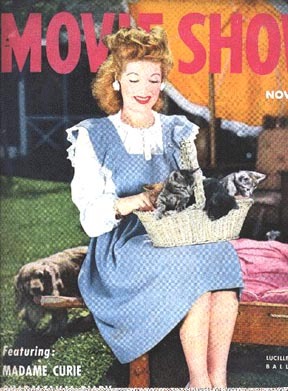
In November 1943, Lucille Ball appeared on the cover of Movie Show Magazine holding a basket of kittens! Note that her dog is lurking in the background!
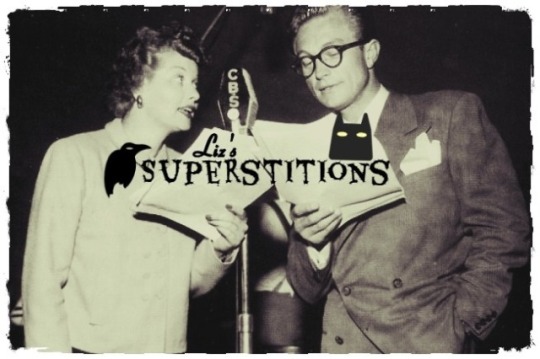
“Liz’s Superstitions” (1949) ~ In this episode of Lucille Ball’s radio series “My Favorite Husband”, Liz (Lucille Ball) is obsessed with superstitions.
LIZ: “If you walk under a ladder it might fall on you. If a black cat walks in front of you, you might trip over it.”
In the usual closing bedroom tag, Liz and George (Richard Denning) are sleeping when a neighborhood cat screeches.
GEORGE: “What’s that?”
LIZ: “Well, it ain’t Bing Crosby.”
Liz tells George to do something about the cat, but he doesn’t know how. Liz solves the problem by throwing something at it.
GEORGE: “What did you throw at him?”
LIZ: “Our cat! Goodnight, George!”
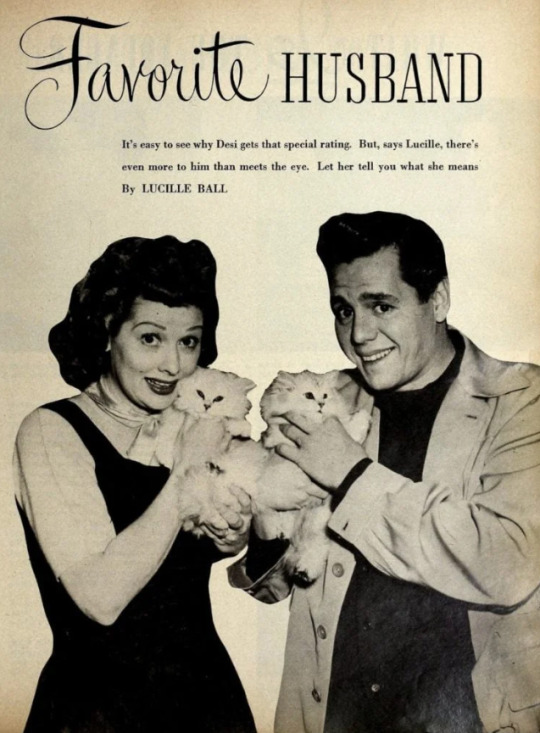
Lucille Ball was an animal lover. She had both cats and dogs, although the dogs seemed to get more press.

It is established that Mrs. Trumbull (Elizabeth Patterson), who lives in the same building with the Ricardos and Mertzes, has a pet cat - although the animalis never given a name. The cat was most famously mentioned in “The Business Manager” (1954) when Mrs. Trumbull asks Lucy to pick up a can of cat food at the market. A can of All Pet is interpreted by Ricky to be a stock named Canadian Allied Petroleum. Is Lucy shopping at the corner market or the stock market?! Interestingly, although the building has a no pets policy we learn about when Little Ricky gets a dog, Mrs. Trumbull’s cat seems exempt from the rule.

“Ricky Minds the Baby” (1954) ~ When Ricky is supposed to be watching the baby, Lucy thinks every sound is Little Ricky crying out for her.
LUCY: “I heard a cry.”
ETHEL: “Oh, wait a minute. That was Mrs. Trumbull's cat.”
LUCY: “Are you sure?”
ETHEL: “I am, unless Little Ricky's sitting on the windowsill going meow.”

Elizabeth Patterson, the actress who played Mrs. Trumbull had starred in the feline films The Cat Creeps (1930) and The Cat and the Canary (1939).

“The Handcuffs” (1952) ~ While Ricky takes a cat nap on the sofa, Lucy sneaks in and handcuffs them together! To rouse Ricky from his sleep, she runs her fingers across his lips. Half asleep, Ricky looks around saying “Here kitty, kitty, kitty”. Is he having a dream or are stray cats allowed to wander around the Ricardo apartment?

“Lucy Does the Tango” (1957) ~ In Connecticut, Bruce Ramsey tells Little Ricky about his cats.
LITTLE RICKY: “We're going to have to get rid of all our chickens. They don't lay enough eggs so my daddy says they got to go.”
BRUCE: “That's what mine said when our cat had kittens.”
LITTLE RICKY: “Did he give the kittens away?”
BRUCE: “He couldn't.”
LITTLE RICKY: “How come?”
BRUCE: “Because I hid the kittens so he couldn't find them.”
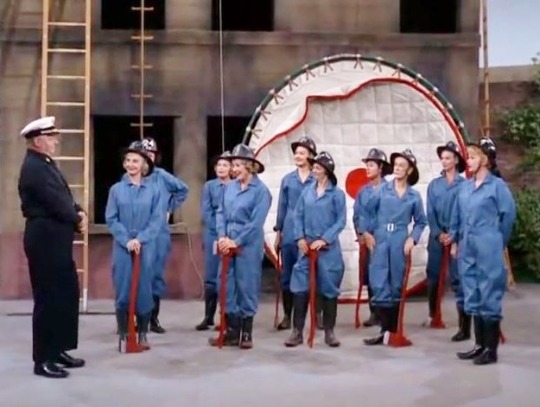
On “The Lucy Show,” the Danfield Volunteer Women’s Fire Brigade brags that they have rescued 43 cats; 12 of them of the same cat. This was likely Grandma Sutton's cat, a reference that has been made several times throughout the series and the reason for the Fire Department's first alarm. Viv says that there was once a rumor that Grandma Sutton had run off with a 22 year-old cat food salesman! Like the cat, Grandma Sutton never appears on screen.
METAPHORICAL CATS

“Nursery School” (1955) ~ Lucy is mad that Ethel let the cat out of the bag about her plan to enroll Little Ricky, but not actually send him to Nursery School.
RICKY (to Ethel): “I wouldn’t know anything around here if you didn’t come up once in a while and spill the beans out of the cat bag.”
LUCY: “It's not ‘spill the beans out of the cat bag’. It's 'spill the beans' or 'let the cat out of the bag’."
Letting the cat out of the bag is a colloquialism meaning to reveal a secret carelessly or by mistake.

The expression is used again in “Don Juan is Shelved” (1955). When Fred reads in Variety that Ricky’s picture has been canceled, she tells him not to mention it to Ricky.
LUCY: “Whatever you do, don't let the cat out of the bag.”
But very quickly Lucy blurts out the news.
FRED: “That cat wasn't let out of the bag. It was yanked out.”
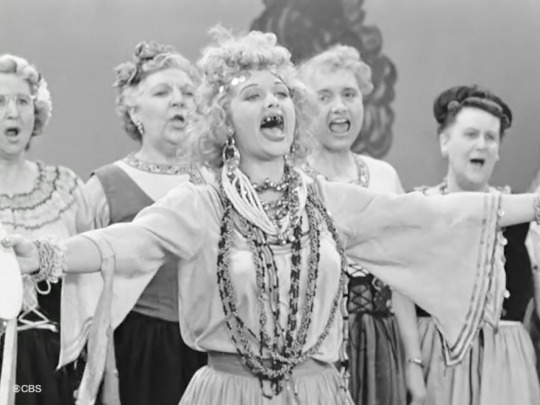
“The Operetta” (1952) ~ Part of Camille’s incantation in song includes:
“I took the wing of an owl!
And the eye of a yak (the eye of a yak)!
The lost brown tooth of an alley cat!”
The chorus keeps chiming in to cover Lucy’s off-key singing.

“Lucy Is Jealous of Girl Singer” (1952) ~ "What Cuban bandleader with the initials R.R. is making cat's eyes at his dancing mouse?” The episode also describes Ricky’s suspected infidelity as playing “cat and mouse”. Webster’s defines the expression as ‘to engage in behavior that is like the way a cat chases a mouse or plays with a mouse before killing it.’

"New Neighbors” (1952) ~ The girls use binoculars to get a glimpse of the new neighbors moving in.
ETHEL: “Let me see through those things.”
LUCY: “Ethel!”
RICKY: “Curiosity killed the cat, eh, Fred?”
FRED: “Yeah, but we'll never get a break like that.”
"Curiosity killed the cat" is a proverb used to warn of the dangers of unnecessary investigation or experimentation. It also implies that being curious can sometimes lead to danger or misfortune.
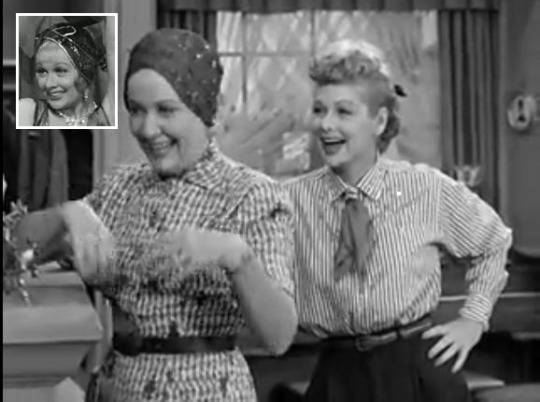
“Lucy Has Her Eyes Examined” (1953) ~ Ethel borrows Lucy’s cloche for a 1920s number.
ETHEL: “Ain't I the cat's pajamas?”
In the 1920s, pajamas were just coming into fashion as women’s apparel, though still slightly risqué. The term ‘cat’ also was coming into use by the flapper set as a slang word for a cool person. Thus, ‘the cat’s pajamas’ became a way to say that someone was cool, great, special, the best.

The episode features Jitterbug expert Arthur ‘King Cat’ Walsh.
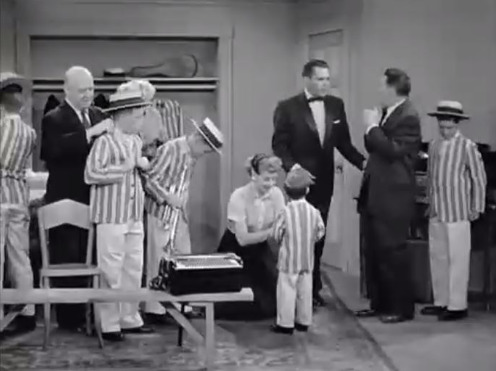
“Little Ricky Gets Stage Fright” (1956) ~ When Little Ricky is going to perform on stage for the first time, the adults are more nervous than he is!
ETHEL: “Oh, I'm as nervous as a cat. I was so nervous, I couldn't eat my breakfast.”
FRED: “And, believe me, for Ethel, that's nervous.”
This expression alludes to the skittishness and anxious behavior of cats.
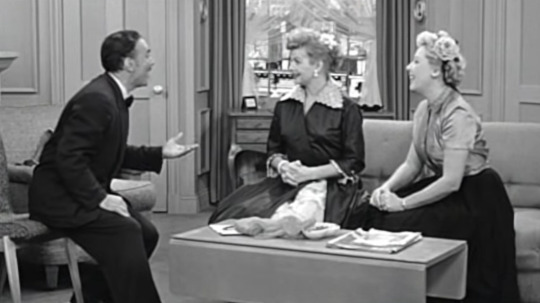
“The French Revue” (1953) ~ Lucy and Ethel get free French lessons from a waiter.
DUBOIS: “Cat?”
LUCY: “Cat. Oh, cat, cat, yes.”
DUBOIS: “Le chat.”
LUCY: “Le chat.”
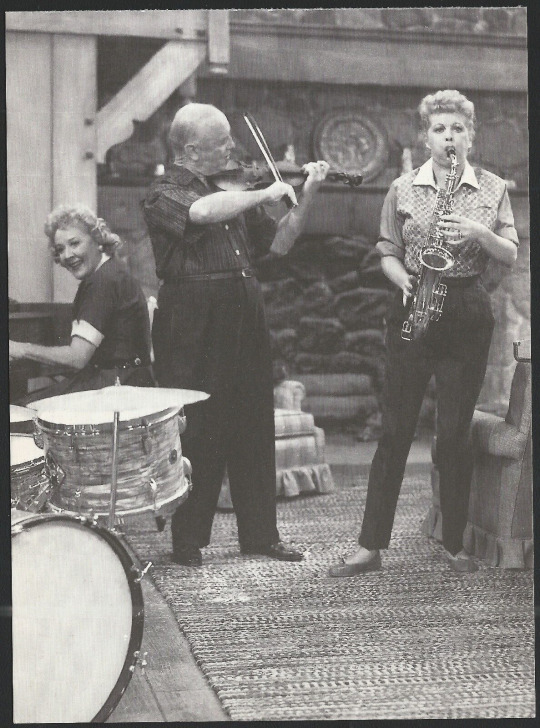
“Ragtime Band” (1957) ~ Fred plays the violin for the PTA show, but the last time he played it was three chins ago at a Roosevelt Rally (Teddy, not Franklin)! Ethel compares his playing to the screeching of a dying cat!
ETHEL: “Oh, Fred, Fred! That cat sounded better when it was alive.”
FRED: “Never mind the wisecracks.”
ACTUAL CATS
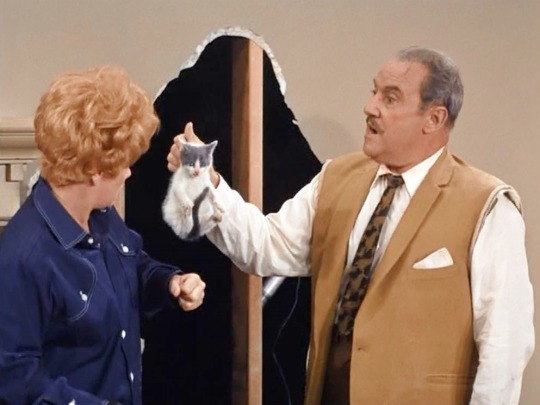
“Lucy the Fixer” (1969) ~ When the wall of Harry’s living room is torn open to repair a light bulb (!) he fins a stray kitten behind the plaster.
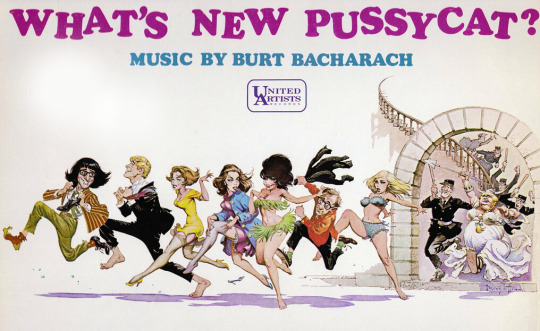
Lucy asks it “What's new pussycat?” which was the title of a 1965 film by Woody Allen and an Oscar-nominated song of the same name by Burt Bacharach and Hal David. The punchline was also used in “Lucy Meets Mickey Rooney” (1966).

On “Here’s Lucy,” Kim (Lucie Arnaz) had a cat she named Harry after her Uncle. Lucy cat-sits with Harry while Kim is busy.
CERAMICAL CATS
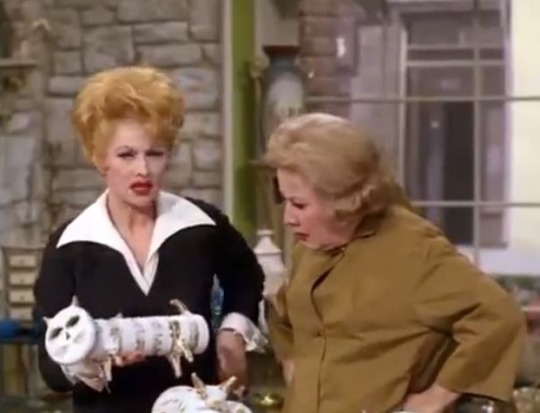
“Lucy and the Ceramic Cat” (1965) ~ When Lucy and Viv are entrusted with Mrs. Mooney’s elegantly wrapped birthday gift, they naturally drop it – shattering it to pieces. They finally figure out what it was - a ceramic cat - and must try to replace it. The cat of the episode’s title was originally designed by master ceramist Aldo Londi (1911-2003), who spent the most of his long and successful career creating exceptional work for Italian ceramics manufactory Bitossi Ceramiche.

A silmilar cat in yellow turns up as set decoration in “Lucy and the French Movie Star” (1967). This one remains safely on the shelf.
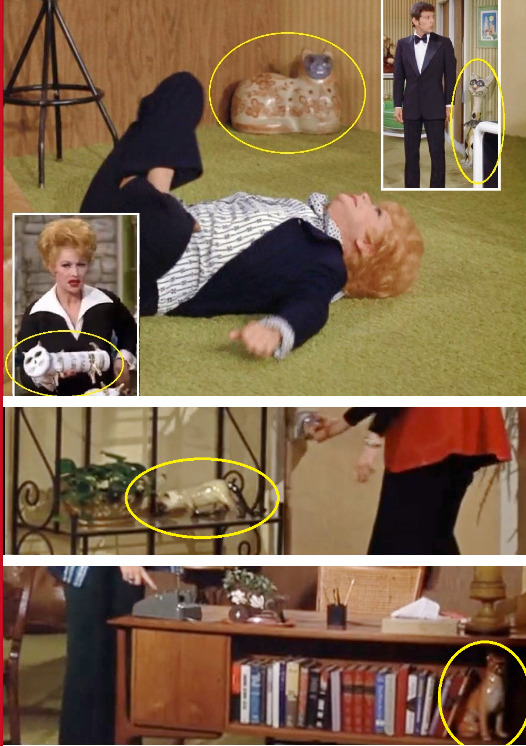
Although Kim’s cat Harry never reappears, there are several ceramic cats in her new apartment. The crazy cat with the long neck was first glimpsed in Flip Wilson’s office in “Lucy and Flip Go Legit” (1971).

Lucille Ball played Kitty Winslow, a dance instructor who inherits a prize fighter in “K.O. Kitty”, a 1959 episode of “The Westinghouse-Desilu Playhouse,” Ball’s first dramatic outing without Desi.

Lucille Ball also played characters named Kitty in Follow the Fleet, The Facts of Life, and Without Love.

“Meanwhile Back at the Office” (1974) ~ Mrs. Skyler’s Kitty Cat, was brought up on milk. Kitty Cat was played by Neil the Lion. But that’s another blog.
#cats#Lucille Ball#Kittens#I Love Lucy#Kitty#The Lucy Show#Here's Lucy#Vivian Vance#Lucie Arnaz#Little Ricky#William Frawley#King Kat Walsh
1 note
·
View note
Text
Sutton Brady : Richard Hunter is the love of my life. We were married for a brief but wonderful time. A time that I will carry with me for the rest of my life. Our marriage ended because of no fault of his or mine but because of the single reason that while I was not meant to be a mom, he was meant to be a dad. Walking away from an amazing husband is the hardest thing I ever had to do, but I also know it’s the right thing to do because letting go means giving a person that I love most in this world a chance at becoming what he was born to be: a father.
Richard Hunter : What I was thinking was there’s no place I would rather be than by your side. Yes, I always wanted kids, but the thing is I want you more. I mean maybe I could adopt a baby, but without you I wouldn’t be happy. Sure, I could meet someone and we could have a kid, but I don’t want to marry anyone else, Sutton. Sutton Brady, will you not divorce me? I can’t imagine living my life without you.
- The Bold Type, Season 5
0 notes
Photo

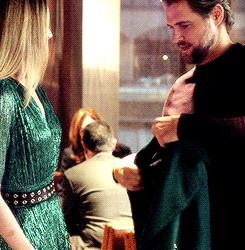
“Let me help you with that. ”
#tbtedit#suttardedit#theboldtypeedit#richard hunter#sutton brady#the bold type#sutton x richard#mine*#did i really mine this micromoment for two whole gifs? the answer is yes#do i care? the answer is no#acts of service is richard hunter's love language pass it on
283 notes
·
View notes
Photo







#theboldtypeedit#theboldtypegifs#chewieblog#tuserella#rapunzels#usersammie#userantara#bbelcher#sutton x richard#sutton brady#richard hunter#the bold type#spoilers#this was heartbreaking :((#mine
361 notes
·
View notes
Photo
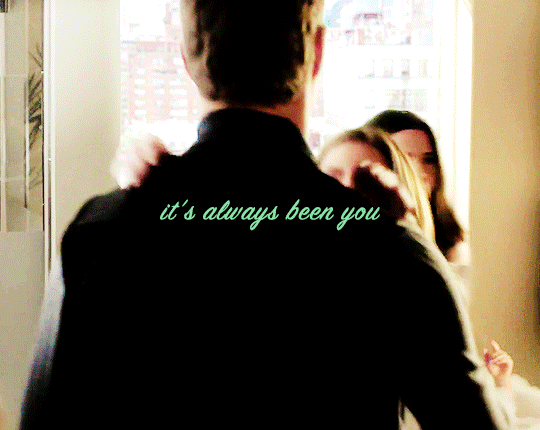









TOP 100 SHIPS OF ALL TIME:
#84. sutton brady and richard hunter (the bold type)
#suttard#tbtedit#theboldtypeedit#suttardedit#sutton brady#richard hunter#the bold type#**#100ships#mine: the bold type#mine: sutton and richard#otp: it's me and you against the world
349 notes
·
View notes
Photo


I love our life. I love us.
#theboldtypeedit#tbtedit#the bold type#dailyboldtype#boldtypesource#theboldtypegifs#suttard#sutton x richard#*#mine: tbt#tv: tbt#let's keep them this way please#we are headed for bad things :(
129 notes
·
View notes
Photo
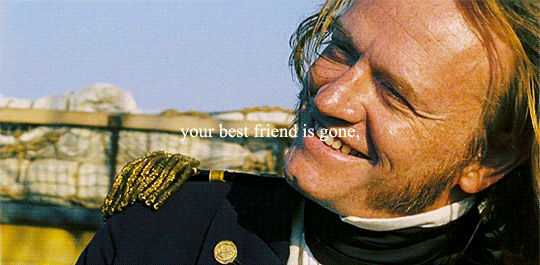

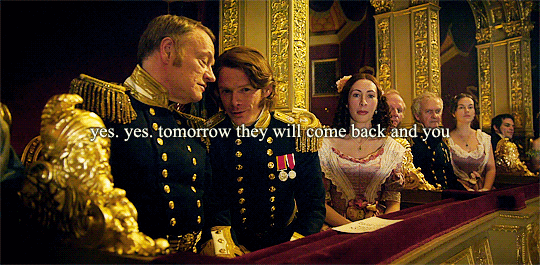

“tomorrow”, mark strand
#the terror#close is nothing/its worse than nothing#sir james clark ross#richard sutton#francis crozier#sir john franklin#jared harris#mine#edits#thoughts
395 notes
·
View notes
Photo


#tbtedit#theboldtypeedit#boldtypeedit#the bold type#suttard#sutton x richard#sutton brady#richard hunter#mine*#gifs*
161 notes
·
View notes
Text
ok, let’s talk about the bold type. spoilers for anyone who hasn’t seen the new episode.
i feel like the reason why sutton doesn’t want kids is due to her horrible childhood. sutton and richard didn’t have a conversation about why sutton doesn’t want kids. there’s also a theory that sutton hasn’t connected the dots to what is the underlying factor to why she doesn’t want kids (her horrible childhood) i also think that if sutton and richard rekindle, they need to go to therapy to help them both understand why sutton doesn’t want kids. in turn richard will hopefully be more understanding and maybe help her to come around to having kids.
#the bold type#sutton brady#richard hunter#sutton x richard#suttard#richard x sutton#tv: the bold type#char: sutton brady#char: richard hunter#ship: sutton x sutton#text#*mine#mine: text
40 notes
·
View notes